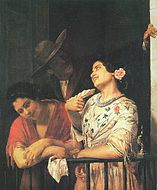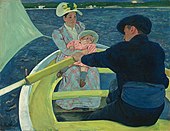Mary Cassatt
Mary Stevenson Cassatt (* 22. May 1844 in Pittsburgh , Pennsylvania , USA ; † 14. June 1926 in the castle Beaufresne, Le Mesnil-Théribus , Oise , France ) was an American illustrator and painter of Impressionism .
life and work
The painter Mary Cassatt was the daughter of Katherine Kelson Johnston and Robert S. Cassatt, a banking family from the Pennsylvanian nobility . At a very young age, during the family's four-year stay in Europe , she got to know the art treasures of European galleries. Against her father's wishes, she decided to become a painter. From 1861 to 1865 she studied at the Pennsylvania Academy of Fine Arts in Philadelphia .
Since 1874 she lived in France, first continued her studies in Paris in the studio of Jean-Léon Gérôme , but soon afterwards finished her academic training (“The teaching of the museums is enough”). She studied with great intensity the paintings of great masters such as Correggio , Velázquez , Titian and Rubens in France, Italy and Spain . In addition to painting, she also dealt with ceramics.
Her own pictures found recognition and were exhibited several times in the Paris Salon . The painter Edgar Degas induced them to join the new movement of the Indépendants (later Impressionists ). “I accepted with joy. ... I rejected conventional art. I began to live. ”She was a close friend of Degas for years and was a model for him on several occasions. From 1879 to 1886 she exhibited regularly together with the Impressionists and also made a significant contribution to the fact that Impressionism became popular in America at an early stage. As early as 1877 she advised her friend, the wealthy New Yorker Louisine W. Havemeyer , to buy pictures by Edgar Degas and Claude Monet . It was probably the first Impressionist paintings to make their way to the United States. The core of this collection, along with works by old masters, came into the possession of the Metropolitan Museum in New York in 1929. Cassatt later also advised Bertha Honoré Palmer from Chicago on building up her art collection, which can now be seen at the Art Institute of Chicago .
Her main artistic theme - as Berthe Morisot was also concerned with - from 1886 on were women, especially the subject of "mother and child". In their pictures they appear in all imaginable situations in the context of the bourgeois way of life towards the end of the 19th century - together with their children or reading, having tea, at the opera. Cassatt deliberately chose a motif in order to free herself from Degas, who exerted great artistic influence on her. The opera is remarkable as a motif, as a place provided with artificial light. In addition to the oil paintings in the opera, she also made pastels in which she experimented with metallic colors in order to capture the dazzling theatrical atmosphere.
Her parents and sister had lived in Paris since 1877. Mary had to take care of a bigger household in addition to her artistic work for 18 years. Still, she found time to inspire, encourage, and generously support young art students. In the 1880s, Cassatt turned to graphics in addition to painting. Her entire graphic work comprises about two hundred and eighty works. After seeing Japanese woodblock prints in Paris in 1890 , she also tried successfully in this field. Her series of ten color prints formed an important part of her successful solo exhibition in 1893 in the Durand-Ruel Gallery, in which she had already presented works in 1891. In 1898 her work was shown in the gallery's New York branch.
In 1892 Cassatt was commissioned to paint the north tympanum of the Colombian Pavilion at the Chicago World's Fair in 1893. In 1894 the artist acquired Beaufresne Castle on the Oise, which, along with her Paris studio, became the focal point for art encounters .
In 1904 she was accepted as a knight in the French Legion of Honor , in 1914 she was awarded the gold medal of the Pennsylvania Academy of the Fine Arts (PAFA). She had previously turned down two other prizes, the Lippincott Prize from PAFA and the Harris Prize from the Art Institute of Chicago, as this seemed to her to be incompatible with her understanding of art.
The loss of sight ended her time as a painter in 1914.
Some pictures
Louisine W. Havemeyer ,
Shelburne Museum
literature
- Mary Cassatt at FemBiographie
- Mary Cassatt in the Encyclopædia Britannica Online (English)
- Christina Haberlik, Ira Diana Mazzoni : 50 classics - artists, painters, sculptors and photographers . Gerstenberg, Hildesheim 2002, ISBN 978-3-8067-2532-2 , pp. 84-89
- Christiane Weidemann, Petra Larass, Melanie Klier: 50 women artists you should know . Prestel Munich 2008, ISBN 978-3-7913-3957-3 , pp. 68-71
- Ingrid Pfeiffer (Ed.): Impressionists . Hatje Cantz, Ostfildern 2008, ISBN 3-7757-2078-2
- Debra N. Mancoff: Women Who Changed Art . Prestel Munich 2012, ISBN 978-3791347325 , pp. 19. 32-33
- Judith Barter: Mary Cassatt. Modern woman. Abrams, New York 1998, ISBN 0-8109-4089-2
- Griselda Pollock : Mary Cassatt. London 1980
Web links
- Mary Cassatt at Google Arts & Culture
- Literature by and about Mary Cassatt in the catalog of the German National Library
- Life and pictures (English)
- Mary Cassatt. In: FemBio. Women's biography research (with references and citations).
- Mary Cassatt Metropolitan Museum of Art (Engl.)
- Works by Mary Cassatt at Zeno.org
- Marc Harden's Art Archive
- Mary Cassatt in the nndb (English)
- Mary Cassatt at the National Gallery of Art (English)
Individual evidence
- ↑ The information on the year of birth is inconsistent, as NNDB mentions 1843, Zeno 1845, most other sources such as the Encyclopedia Britannica cite the year 1844.
- ↑ Tamara Préaud and Serge Gauthier: The art of ceramics in the 20th century . Edition Popp im Arena Verlag , Würzburg 1982, ISBN 3-88155-099-2 , p. 84 .
| personal data | |
|---|---|
| SURNAME | Cassatt, Mary |
| ALTERNATIVE NAMES | Cassatt, Mary Stevenson (full name) |
| BRIEF DESCRIPTION | American impressionist painter |
| DATE OF BIRTH | May 22, 1844 |
| PLACE OF BIRTH | Pittsburgh , Pennsylvania |
| DATE OF DEATH | June 14, 1926 |
| PLACE OF DEATH | Beaufresne Castle, Le Mesnil-Théribus , Oise Department, France |












